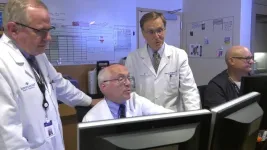(Press-News.org) While more people than ever are running marathons in the U.S., the risk of dying from a heart attack during a run has fallen dramatically in recent years. That’s a key conclusion from a new study by Jonathan Kim, associate professor in the Emory School of Medicine. Kim’s research is a follow-up to a study he published in 2012 – the first investigation into unexpected cardiac arrests during long distance running events.
The new findings, published in JAMA, indicate that while the rate of marathon runners who suffer cardiac arrests remained unchanged, their chance for survival is twice what it was in the past. Now, far fewer marathon runners who suffer cardiac arrest are dying of it.
“We continue to see media reports about unfortunate cases of cardiac arrest during long distance running events,” Kim says. “But, has the incidence of these events changed? Have there been changes in the most common causes of cardiac arrest? What are the factors associated with death and survival? It was a novel question to ask 13 years after our first analysis, and an important one because recreational running continues to increase in popularity.”
The challenge of finding data
More than 29 million people completed marathons in the U.S. between 2010 and 2023, triple the number of the previous decade, which Kim examined in his first study. There’s no central registry of race-related cardiac events, so for both studies, his team had to find their data through a range of sources, starting by contacting individual race directors.
“We leveraged a few sources including a comprehensive review of media reports,” Kim says. “We also had contact information for all race directors and were able to reach approximately 70% of them who helped and told us the number of events during this specific timeline, including if the individual died and the sex of the participant.”
The researchers used extensive public internet searches to identify and reach out to runners who survived cardiac arrests, or next-of-kin, to construct detailed profiles of as many cases as possible. “The vast majority of cases were identifiable by public search engines. And all of the deaths were as well,” Kim says.
Analyzing this extensive database, Kim found that while the rate of cardiac arrests was about the same during the two periods – .60 per 100,000 participants now versus .54 per 100,000 participants in the earlier period – the rate of deaths from these cases, however, fell by half: from .39 per 100,000 to .19 per 100,000. That’s about a 50% decline in the death rate since 2000-2009. As before, cardiac arrests remained far more common among men than among women and more common in marathons than half marathons.
The sport’s growing awareness of cardiac death risk
What led to the dramatic change in death rates? Kim thinks the whole sport has become more aware of the risks and of the need to have emergency services available to runners, a conclusion he reached after interviewing as many survivors as he could find. “What we found was that every one of those people got hands-on cardiopulmonary resuscitation, but the vast majority also had immediate access to an automated external defibrillator. That’s the difference,” he says.
That survival rate is comparable to the cardiac arrest survival rate in other public places that now make defibrillators routinely available such as airports and casinos, which have seen similar declines in deaths.
Kim says his findings offer additional evidence of how important it is to make CPR training available to race participants and to strategically place defibrillators along the racecourse. It’s also important, he says, to better identify the most vulnerable in a population before they run a race.
“These are more often potentially preventable events,” Kim says. “Being able to identify people, more commonly older individuals with unrecognized cardiovascular risk factors, doesn’t mean they can’t run a race. Rather, it affords the opportunity to improve primary preventive cardiovascular care and potentially further reduce the risk of cardiac arrest during these events. The incidence of sudden cardiac arrest during long-distance races hasn’t changed in over 20 years. I think this is an important arena of future research.”
CITATION: "Cardiac Arrest During Long-Distance Running Races." JAMA. March 30, 2025. doi:10.1001/jama.2025.3026.
END
Preventable cardiac deaths during marathons are down, Emory study finds
2025-03-30
ELSE PRESS RELEASES FROM THIS DATE:
New study finds peripheral artery disease often underdiagnosed and undertreated; opportunity to improve treatments, lower death rates
2025-03-30
A new Intermountain Health study finds that peripheral artery disease, a condition that affects more than 10 million Americans over the age of 40, is often underdiagnosed and undertreated, with fewer women getting guideline-directed medical therapy than men.
As a result, combined with this highly debilitating disease, patients with peripheral artery disease have a more than 50 percent chance of dying from the condition.
Peripheral artery disease affects nearly 10 percent of the US population. It occurs when the arteries that carry blood to the legs and arms become narrowed or blocked by plaque ...
Use of antidepressant medication linked to substantial increase in risk of sudden cardiac death
2025-03-30
Vienna, Austria- 30 March 2025
Sudden cardiac death (SCD) refers to an unexpected death of a person, believed to be caused by a heart-related issue. It occurs within one hour of the onset of symptoms in witnessed cases or within 24 hours of the person being last seen alive in unwitnessed cases.
The causes in people under the age of 39 are often a thickening of the heart muscle or an electrical problem with the heart. In older people, SCD is more likely to be caused by a narrowing of the blood vessels that supply the heart.
Previous research has shown1 that patients with psychiatric disorders have an increased all-cause mortality ...
Atrial fibrillation diagnosed in midlife is linked to a 21% increased risk of dementia at any age and a 36% higher risk of early-onset dementia
2025-03-30
Vienna, Austria- 31 March 2025
New research presented at the EHRA 2025, a scientific congress of the European Society of Cardiology, shows that the presence of atrial fibrillation (AF) increases the risk of future dementia by 21% in patients diagnosed with AF under 70 and the risk of early-onset dementia (diagnosed before age 65 years) by 36%. The association was stronger in younger adults and was lost in older adults aged 70 years and over.
“This is the largest European population-based study evaluating the association between AF and dementia,” say the authors that include Dr Julián Rodriguez ...
Mode of death in patients with heart failure with mildly reduced or preserved ejection fraction
2025-03-30
About The Study: Among patients with heart failure with mildly reduced ejection fraction/heart failure with preserved ejection fraction in the Finerenone Trial to Investigate Efficacy and Safety Superior to Placebo in Patients With Heart Failure randomized clinical trial, higher proportions of cardiovascular and overall mortality in those with ejection fraction less than 50% were related principally to higher proportions of sudden death. A clear treatment effect of finerenone on cardiovascular or cause-specific mortality was not identified, although the trial was likely underpowered for these outcomes.
Corresponding Author: To contact the corresponding author, Akshay S. Desai, ...
Intravenous ferric carboxymaltose in heart failure with iron deficiency
2025-03-30
About The Study: In patients with heart failure and iron deficiency, ferric carboxymaltose did not significantly reduce the time to first heart failure hospitalization or cardiovascular death in the overall cohort or in patients with a transferrin saturation less than 20%, or reduce the total number of heart failure hospitalizations vs placebo.
Corresponding Author: To contact the corresponding author, Stefan D. Anker, MD, PhD, email s.anker@cachexia.de.
To access the embargoed study: Visit our For The Media website at this link https://media.jamanetwork.com/
(doi:10.1001/jama.2025.3833)
Editor’s ...
Artificial intelligence in the prevention of sudden death
2025-03-30
Many cases of sudden cardiac death could be avoided thanks to artificial intelligence. As part of a new study to be published in European Heart Journal, a network of artificial neurons imitating the human brain was developed by researchers from Inserm, Paris Cité University and the Paris public hospitals group (AP-HP), in collaboration with their colleagues in the USA. During the analysis of data from over 240 000 ambulatory electrocardiograms, this algorithm identified patients at risk of a serious arrhythmia that was capable of triggering cardiac arrest within the following 2 weeks in over 70% of cases.
Each ...
Oral semaglutide vastly reduces heart attacks, strokes in people with type 2 diabetes
2025-03-29
Both the injectable and oral forms of semaglutide, a glucagon-like peptide-1 receptor agonist, have gained recent attention for their effectiveness against weight gain, high blood sugar, and even alcohol cravings.
A new clinical trial, co-led by endocrinologist and diabetes expert John Buse, MD, PhD, and interventional cardiologist Matthew Cavender, MD, MPH, at the UNC School of Medicine has shown that the oral form of semaglutide can significantly reduce cardiovascular events in people with type 2 diabetes, atherosclerotic cardiovascular disease, and/or ...
Prothrombin complex concentrate vs frozen plasma for coagulopathic bleeding in cardiac surgery
2025-03-29
About The Study: In this unblinded randomized clinical trial, prothrombin complex concentrate had superior hemostatic efficacy and safety advantages to frozen plasma among patients requiring coagulation factor replacement for bleeding during cardiac surgery.
Corresponding Author: To contact the corresponding author, Keyvan Karkouti, MD, email keyvan.karkouti@uhn.ca.
To access the embargoed study: Visit our For The Media website at this link https://media.jamanetwork.com/
(doi:10.1001/jama.2025.3501)
Editor’s Note: Please see the article for additional information, including other authors, author contributions and affiliations, ...
Who needs a statin? New study compares prescribing recommendations based on traditional risk factors vs. coronary artery calcium scoring
2025-03-29
A new study by researchers at Intermountain Health in Salt Lake City aims to determine the best method to screen and evaluate patients who are at risk of developing coronary heart disease and which patients would benefit from taking a statin medication to lower cholesterol.
Currently, cardiologists determine a patient’s need for a statin based on traditional risk factors, using the Pooled Cohort Equation (PCE), which calculates coronary risk by assessing the risk factors of age, sex, total and HDL cholesterol levels, blood pressure, and whether someone ...
Finerenone and atrial fibrillation in heart failure
2025-03-29
About The Study: The efficacy of finerenone was consistent regardless of atrial fibrillation status in this study. New-onset atrial fibrillation was associated with a substantially higher risk of subsequent outcomes.
Corresponding Author: To contact the corresponding author, John J. V. McMurray, MD, email john.mcmurray@glasgow.ac.uk.
To access the embargoed study: Visit our For The Media website at this link https://media.jamanetwork.com/
(doi:10.1001/jamacardio.2025.0848)
Editor’s Note: Please see the article for additional information, including other authors, ...



